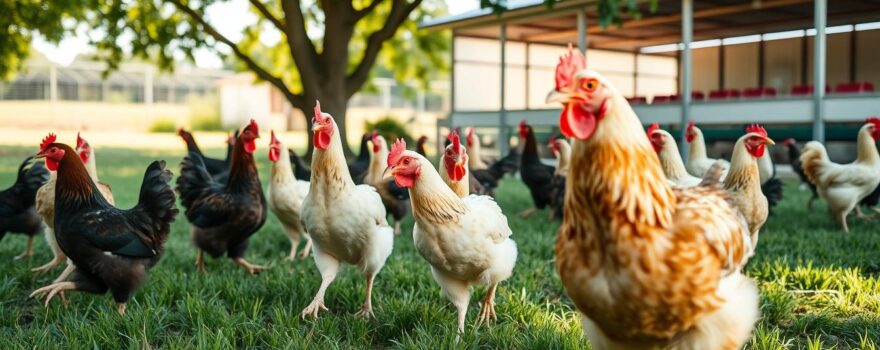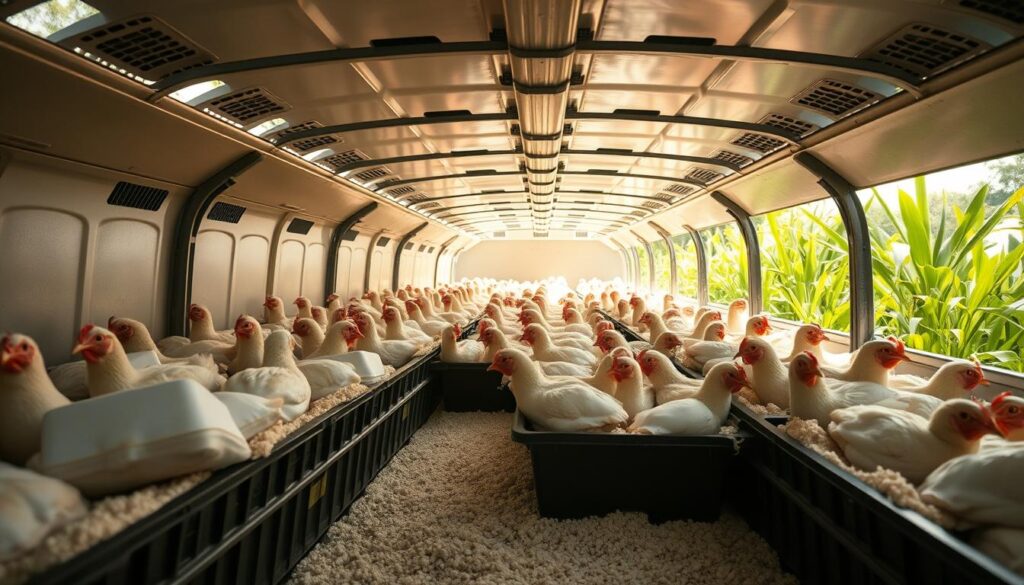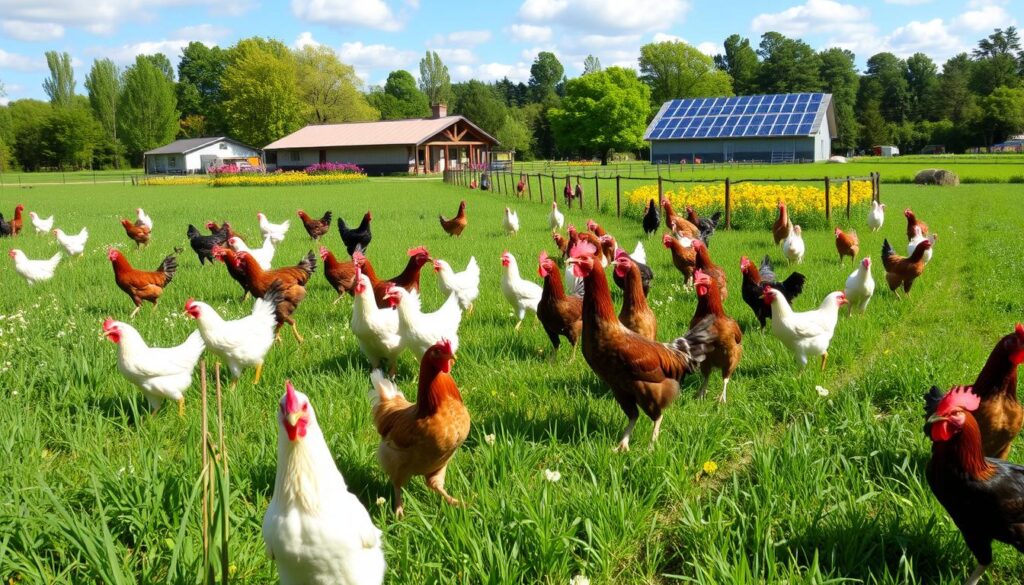
Poultry farming is key to meeting the world’s need for affordable, nutritious protein. The well-being of broiler chickens, the most common poultry, is crucial. This article offers a detailed guide on improving broiler farming to better animal welfare, productivity, and sustainability.
The American Humane Farm Program’s Animal Welfare Standards for broiler highlight the need for humane treatment and proper management. By following these standards, farmers can create a better environment for the birds. This leads to better animal welfare, less stress, and higher productivity.
Key Takeaways
- Understand the ethical and economic benefits of implementing humane broiler farming practices.
- Ensure broiler housing meets space, lighting, and ventilation requirements for optimal welfare.
- Incorporate enrichment strategies and stress reduction techniques to create a positive broiler environment.
- Adhere to guidelines for humane transportation and slaughter to minimize suffering.
- Adopt sustainable production methods that integrate animal welfare and environmental sustainability.
Understanding the Importance of Broiler Welfare
Broiler welfare is key in today’s poultry farming. It’s not just about doing the right thing for the animals. It also brings big economic benefits when we follow ethical considerations in broiler production. Caring for broilers well can make them grow better, live longer, and attract more customers who want ethically raised chicken.
Ethical Considerations in Broiler Production
Broiler chickens feel pain, distress, and suffering just like we do. So, it’s our duty to give them enough space, fresh air, clean water, and good food. Following welfare best practices is not only right but also makes the whole flock healthier and more productive.
Economic Benefits of Humane Broiler Farming
- Improved feed conversion: Chickens in happy, stress-free places eat better and give more meat, making more money.
- Reduced mortality rates: Good care lowers disease and injury, leading to more chickens to sell.
- Enhanced consumer demand: People who care about animals want to buy chicken that’s raised right, giving farms an edge.
By focusing on both the welfare of broilers and making money, farms can be both kind and profitable. This way, they can make a business that cares for its animals and does well financially.
“The true measure of a civilization is how it treats its most vulnerable members.”
– Mahatma Gandhi
Broiler Housing Standards for Optimal Welfare
Keeping broiler chickens happy and healthy is key for ethical and sustainable farming. The right design and management of their housing is crucial. Meeting these standards helps meet their natural behaviors and needs.
Space Requirements and Stocking Density
Enough space is vital for broiler welfare. Experts say each bird should have at least 0.75 square meters of floor space. The maximum stocking density should be 34 kilograms per square meter. This lets broilers move freely and avoid stress and health problems from overcrowding.
Lighting and Ventilation Needs
Good lighting and air flow are also important. Broiler houses need a light intensity of 20-40 lux during the day. They should also have a dark period of at least 6 hours for rest. Ventilation systems should keep the air temperature between 20-26°C and the relative humidity between 50-70%. This ensures the air is fresh and free from harmful gases.
| Housing Standard | Recommended Specification |
|---|---|
| Space Allowance | Minimum 0.75 square meters per bird |
| Stocking Density | Maximum 34 kilograms per square meter |
| Lighting Intensity | 20-40 lux during the day |
| Dark Period | Minimum 6 hours |
| Temperature | 20-26°C |
| Relative Humidity | 50-70% |
Following these housing standards helps create a better environment for broilers. This leads to better health, productivity, and a more ethical and sustainable poultry industry.
How to Implement Welfare Best Practices in Broiler Farming
It’s vital for broiler farming to focus on animal welfare. This ensures the well-being of the animals and meets industry standards. Key strategies include housing, enrichment, transportation, and slaughter practices.
First, broilers need enough space and good housing. This means the right stocking density, good ventilation, and lighting. Also, adding features like perches and dust baths helps them behave naturally.
- Set the right stocking density for easy movement and access to resources.
- Keep ventilation and temperature in check for a comfortable environment.
- Add enrichment like perches, hay bales, and dust baths to reduce stress.
Reducing stress and suffering is also crucial. This involves gentle handling, careful transport, and humane slaughter.
- Use gentle handling to minimize distress during routine tasks.
- Ensure safe and comfortable transport to the destination.
- Choose humane slaughter methods that prioritize animal welfare.
By following these practices, broiler farmers can improve animal lives. They also meet consumer demands and benefit economically from humane farming.
“Implementing welfare best practices is not just the right thing to do, it’s also a smart business decision. Consumers are increasingly demanding more ethical and sustainable food production, and broiler farmers who prioritize animal welfare can gain a competitive edge.”
Enriched Environments for Broiler Chickens
It’s very important to give broiler chickens a good place to live. A good environment helps them behave naturally and feel less stressed. This makes them healthier and happier.
One key thing is to give them perches. Perches let the birds rest and explore, just like they would in the wild. Research shows that birds with perches are less aggressive and have better leg health. This is good for their overall well-being.
Also, having enough litter material is crucial. Broilers like to forage and scratch, and litter lets them do that. A thick layer of litter, like wood shavings or straw, keeps them active and happy. It also keeps their living area clean and dry, which helps prevent health problems.
- Perches for roosting and exploration
- Litter material for foraging and scratching
- Hay bales or other objects for climbing and perching
- Visual barriers to create distinct areas for rest, activity, and feeding
Adding these enrichment features makes a big difference. It makes the birds’ lives better and can even make the farm more productive. This is good for the birds and for the farm’s future.
| Enrichment Feature | Benefits |
|---|---|
| Perches | Reduced aggression, improved leg health |
| Litter Material | Encourages natural foraging and scratching behaviors, maintains a clean environment |
| Hay Bales or Other Objects | Provide opportunities for climbing and perching, additional mental and physical stimulation |
| Visual Barriers | Create distinct areas for rest, activity, and feeding, reducing stress and enhancing welfare |
By making their environments better, broiler farmers help their birds and the industry too. It’s a step towards a more sustainable and ethical way of raising broilers.
Broiler Stress Reduction Techniques
Keeping broiler chickens happy is key for ethical and sustainable farming. Important steps include enriching their environment and handling them gently. This helps reduce stress in the flock.
Environmental Enrichment for Stress Relief
Creating a rich environment can help chickens feel less stressed. Here are some ways to do it:
- Adding perches and platforms for natural roosting
- Using straw or hay for pecking and foraging
- Creating hiding spots and dust baths for instinctual behaviors
- Changing the lighting to mimic day and night
Handling and Transportation Guidelines
It’s important to keep chickens calm during handling and transport. Here’s how:
- Use gentle methods to catch and load chickens
- Make sure they have enough space, air, and cool temperatures during transport
- Focus on their comfort and safety when loading and unloading
- Transport them during cooler times to avoid heat stress
Using these techniques can improve chicken welfare and also save money. Healthier birds are more productive and profitable.
| Technique | Benefits |
|---|---|
| Perches and platforms | Allows natural roosting behaviors, reduces stress |
| Pecking substrates | Encourages foraging and exploration, decreases boredom |
| Hiding spots and dust baths | Enables instinctual behaviors, promotes natural comfort |
| Varied lighting schedule | Mimics natural day-night cycles, reduces chronic stress |
| Gentle handling and transport | Avoids injury and distress, maintains health and productivity |
“Implementing effective broiler stress reduction techniques is not only the ethical choice, but also a smart business decision. Healthier, less stressed birds lead to better productivity and profitability.”
Humane Broiler Transportation Practices
The welfare of broiler chickens is important even after they leave the farm. Proper transportation is key to keeping them safe and comfortable. By using humane practices, producers can lower stress and prevent injuries, ensuring the best care for these animals.
Vehicle Design and Maintenance
The design and condition of transport vehicles are vital for broiler welfare. Producers must ensure trailers have:
- Good ventilation for the right temperature and air quality
- Non-slip flooring to prevent falls and injuries
- Padded walls and suspension systems to cushion against bumps and vibrations
- Proper insulation to protect birds from extreme weather
Loading and Unloading Procedures
Careful handling is key during loading and unloading. Producers should train staff in gentle, low-stress techniques, such as:
- Using electric prods or other aversive tools as little as possible
- Providing ramps or gentle inclines for easy access
- Ensuring proper stocking density to prevent overcrowding
- Monitoring birds for signs of distress and taking immediate action
Journey Planning and Route Optimization
The duration and route of broiler transport matter for animal welfare. Producers should plan their logistics to:
- Keep journey times short and avoid delays
- Choose routes that avoid heavy traffic and rough roads
- Provide rest stops and access to food and water during longer journeys
By focusing on humane broiler transportation, producers can ensure the highest animal welfare standards. These practices not only benefit the chickens but also help the industry’s long-term success and reputation.

Ethical Broiler Slaughter and Processing Methods
In the poultry industry, treating broiler chickens ethically during slaughter is key. It’s not just right; it also helps producers save money. Humane practices can lead to better profits.
Minimizing Suffering during Slaughter
The industry has developed ways to treat broiler chickens well. These methods aim to reduce their pain and stress. They also keep food safe and of high quality.
- Proper stunning techniques, like electrical or gas stunning, make birds unconscious before slaughter. This way, they don’t feel pain or fear.
- Humane handling and restraint are used throughout. This keeps the animals calm and reduces their stress.
- Slaughter is done quickly and efficiently. Skilled workers follow guidelines to make sure it’s painless and fast.
Following these ethical methods, producers meet their moral duties. They also make their businesses more sustainable and profitable.
| Slaughter Technique | Description | Benefit |
|---|---|---|
| Electrical Stunning | Broilers are made unconscious with an electric current | It reduces pain and distress, ensuring a humane death |
| Gas Stunning | Broilers are made unconscious with a gas mix, like carbon dioxide | It lowers handling stress, making the slaughter process calmer |
By focusing on ethical slaughter and processing, producers meet their moral duties. They also gain from a more sustainable and profitable business.
Sustainable Broiler Production Strategies
The demand for poultry is growing fast. Broiler farmers must find new ways to care for animals and protect the environment. It’s key for the broiler industry to thrive in the long run.
Integrating Welfare and Environmental Sustainability
Good broiler farming means caring for birds and the planet. This can be done in many ways. For example:
- Setting high animal welfare standards to give birds enough space and comfort.
- Using solar or wind power to cut down on fossil fuel use.
- Creating systems to manage waste and keep the environment clean.
- Using water wisely to save this precious resource.
- Developing feeds that are good for the planet and the birds.
By using these strategies, farmers can make the broiler industry better for everyone. It will meet the demand for chicken while keeping animals and the environment safe.

“Sustainable broiler farming is not just about maximizing profits, but about creating a harmonious balance between animal welfare and environmental responsibility.”
Regulatory Frameworks for Broiler Welfare
Regulatory frameworks are key in broiler farming, ensuring bird welfare. They guide humane treatment and sustainable practices. This is crucial for the industry’s ethics and success.
The United States Department of Agriculture (USDA) is a major regulatory body in the U.S. It oversees certifications and programs for better broiler welfare. For example, the USDA Organic certification has strict rules for living conditions and the use of antibiotics and hormones.
Industry-led initiatives like the Global Animal Partnership (GAP) and American Humane Certified program are also important. They offer standards for animal behavior, health, and environmental enrichment. This ensures better animal welfare.
Broiler farmers must follow these guidelines closely. Regular audits and compliance checks are vital. By doing so, farmers improve animal welfare and meet consumer demand for ethically-sourced poultry.
The regulatory landscape for broiler welfare is getting stronger. It focuses on transparency, accountability, and top animal care standards. Broiler farmers must stay informed and adapt to these changes. This will help create a more humane and sustainable future for their operations.
Adopting broiler welfare best practices is key for ethical, economical, and sustainable broiler farming. It improves the life of broiler chickens and brings economic benefits. It also makes the food system more environmentally friendly.
Optimal housing, enriched environments, and humane transport and slaughter are crucial. They boost broiler health and productivity, making farmers more profitable. These practices also meet the growing demand for ethical and sustainable food.
As the broiler farming industry grows, staying updated on broiler welfare best practices, ethical broiler farming, and sustainable broiler production is vital. Embracing these principles ensures animal well-being, meets consumer expectations, and supports a responsible and prosperous agriculture.